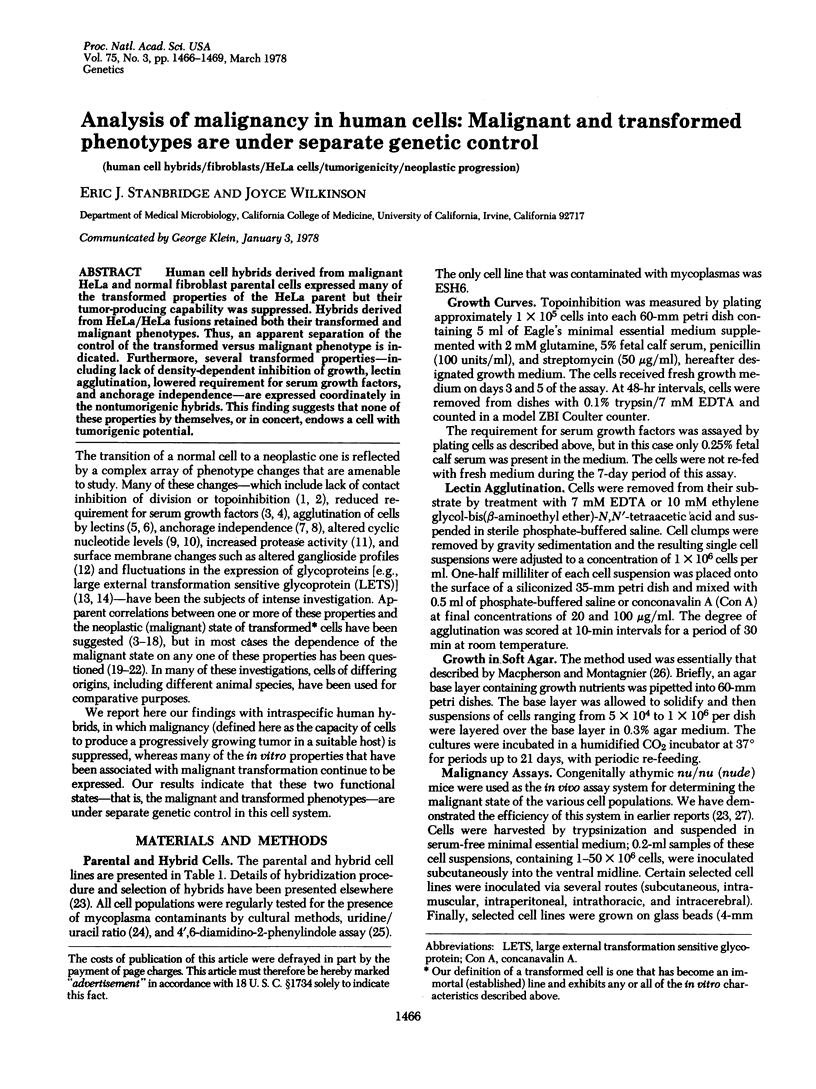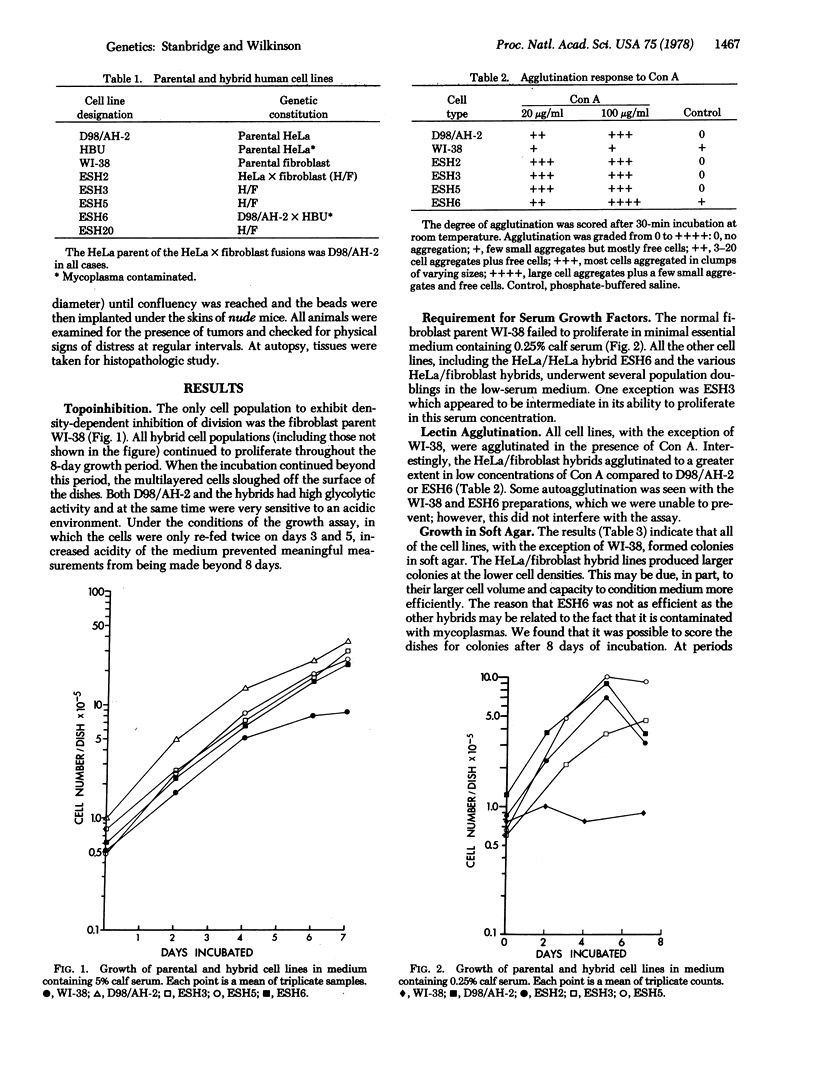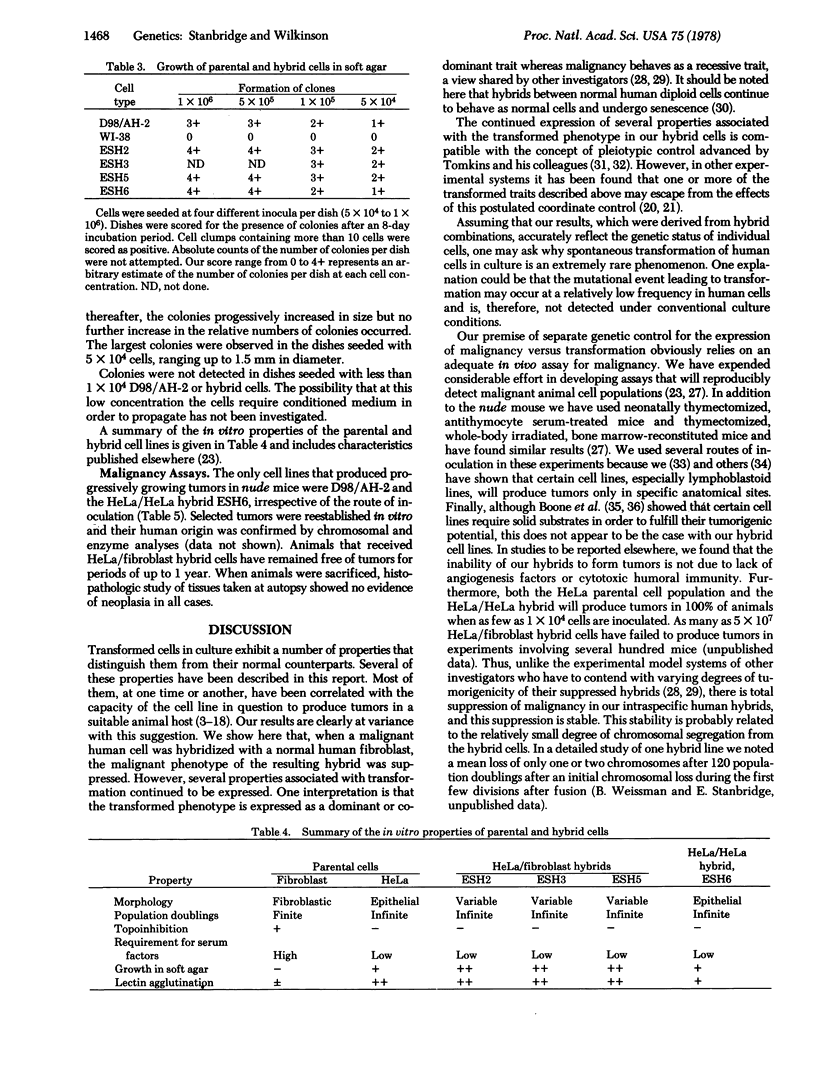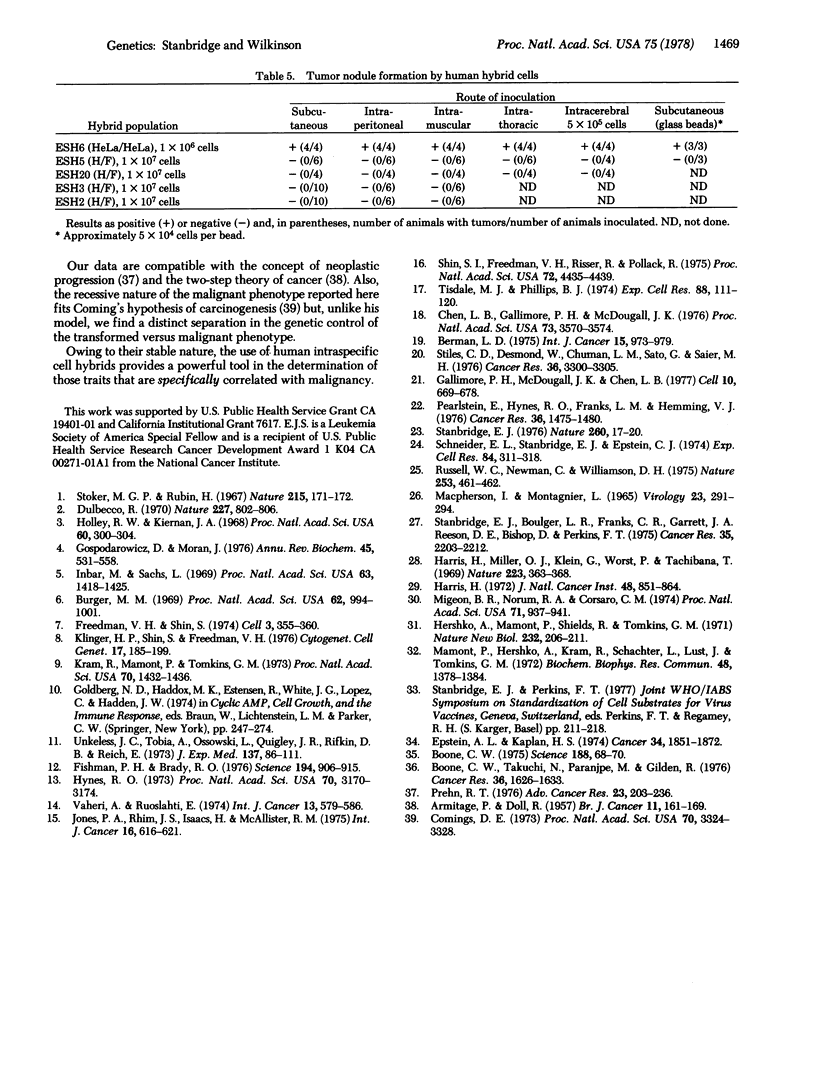Abstract
Human cell hybrids derived from malignant HeLa and normal fibroblast parental cells expressed many of the transformed properties of the HeLa parent but their tumor-producing capability was suppressed. Hybrids derived from HeLa/HeLa fusions retained both their transformed and malignant phenotypes. Thus, an apparent separation of the control of the transformed versus malignant phenotype is indicated. Furthermore, several transformed properties--including lack of density-dependent inhibition of growth, lectin agglutination, lowered requirement for serum growth factors, and anchorage independence--are expressed coordinately in the nontumorigenic hybrids. This finding suggests that none of these properties by themselves, or in concert, endows a cell with tumorigenic potential.
Full text
PDF



Selected References
These references are in PubMed. This may not be the complete list of references from this article.
- ARMITAGE P., DOLL R. A two-stage theory of carcinogenesis in relation to the age distribution of human cancer. Br J Cancer. 1957 Jun;11(2):161–169. doi: 10.1038/bjc.1957.22. [DOI] [PMC free article] [PubMed] [Google Scholar]
- Berman L. D. Lack of correlation between growth characteristics, agglutinability by plant lectins and the malignant phenotype. Int J Cancer. 1975 Jun 15;15(6):973–979. doi: 10.1002/ijc.2910150613. [DOI] [PubMed] [Google Scholar]
- Boone C. W. Malignant hemangioendotheliomas produced by subcutaneous inoculation of Balb/3T3 cells attached to glass beads. Science. 1975 Apr 4;188(4183):68–70. doi: 10.1126/science.1114343. [DOI] [PubMed] [Google Scholar]
- Boone C. W., Takeichi N., Paranjpe M., Gilden R. Vasoformative sarcomas arising from BALB/3T3 cells attached to solid substrates. Cancer Res. 1976 May;36(5):1626–1633. [PubMed] [Google Scholar]
- Burger M. M. A difference in the architecture of the surface membrane of normal and virally transformed cells. Proc Natl Acad Sci U S A. 1969 Mar;62(3):994–1001. doi: 10.1073/pnas.62.3.994. [DOI] [PMC free article] [PubMed] [Google Scholar]
- Chen L. B., Gallimore P. H., McDougall J. K. Correlation between tumor induction and the large external transformation sensitive protein on the cell surface. Proc Natl Acad Sci U S A. 1976 Oct;73(10):3570–3574. doi: 10.1073/pnas.73.10.3570. [DOI] [PMC free article] [PubMed] [Google Scholar]
- Comings D. E. A general theory of carcinogenesis. Proc Natl Acad Sci U S A. 1973 Dec;70(12):3324–3328. doi: 10.1073/pnas.70.12.3324. [DOI] [PMC free article] [PubMed] [Google Scholar]
- Dulbecco R. Topoinhibition and serum requirement of transformed and untransformed cells. Nature. 1970 Aug 22;227(5260):802–806. doi: 10.1038/227802a0. [DOI] [PubMed] [Google Scholar]
- Epstein A. L., Kaplan H. S. Biology of the human malignant lymphomas. I. Establishment in continuous cell culture and heterotransplantation of diffuse histiocytic lymphomas. Cancer. 1974 Dec;34(6):1851–1872. doi: 10.1002/1097-0142(197412)34:6<1851::aid-cncr2820340602>3.0.co;2-4. [DOI] [PubMed] [Google Scholar]
- Fishman P. H., Brady R. O. Biosynthesis and function of gangliosides. Science. 1976 Nov 26;194(4268):906–915. doi: 10.1126/science.185697. [DOI] [PubMed] [Google Scholar]
- Freedman V. H., Shin S. I. Cellular tumorigenicity in nude mice: correlation with cell growth in semi-solid medium. Cell. 1974 Dec;3(4):355–359. doi: 10.1016/0092-8674(74)90050-6. [DOI] [PubMed] [Google Scholar]
- Gallimore P. H., McDougall J. K., Chen L. B. In vitro traits of adenovirus-transformed cell lines and their relevance to tumorigenicity in nude mice. Cell. 1977 Apr;10(4):669–678. doi: 10.1016/0092-8674(77)90100-3. [DOI] [PubMed] [Google Scholar]
- Gospodarowicz D., Moran J. S. Growth factors in mammalian cell culture. Annu Rev Biochem. 1976;45:531–558. doi: 10.1146/annurev.bi.45.070176.002531. [DOI] [PubMed] [Google Scholar]
- Harris H., Miller O. J., Klein G., Worst P., Tachibana T. Suppression of malignancy by cell fusion. Nature. 1969 Jul 26;223(5204):363–368. doi: 10.1038/223363a0. [DOI] [PubMed] [Google Scholar]
- Hershko A., Mamont P., Shields R., Tomkins G. M. "Pleiotypic response". Nat New Biol. 1971 Aug;232(33):206–211. [PubMed] [Google Scholar]
- Holley R. W., Kiernan J. A. "Contact inhibition" of cell division in 3T3 cells. Proc Natl Acad Sci U S A. 1968 May;60(1):300–304. doi: 10.1073/pnas.60.1.300. [DOI] [PMC free article] [PubMed] [Google Scholar]
- Hynes R. O. Alteration of cell-surface proteins by viral transformation and by proteolysis. Proc Natl Acad Sci U S A. 1973 Nov;70(11):3170–3174. doi: 10.1073/pnas.70.11.3170. [DOI] [PMC free article] [PubMed] [Google Scholar]
- Inbar M., Sachs L. Interaction of the carbohydrate-binding protein concanavalin A with normal and transformed cells. Proc Natl Acad Sci U S A. 1969 Aug;63(4):1418–1425. doi: 10.1073/pnas.63.4.1418. [DOI] [PMC free article] [PubMed] [Google Scholar]
- Jones P. A., Rhim J. S., Isaacs H., Jr, McAllister R. M. The relationship between tumorigenicity, growth in agar and fibrinolytic activity in a line of human osteosarcoma cells. Int J Cancer. 1975 Oct 15;16(4):616–621. doi: 10.1002/ijc.2910160411. [DOI] [PubMed] [Google Scholar]
- Klinger H. P., Shin S., Freedman V. H. Enhance anchorage independence and tumorigenicity of aneuploid Chinese hamster cells with nearly doubled chromosome complements. Cytogenet Cell Genet. 1976;17(4):185–199. doi: 10.1159/000130712. [DOI] [PubMed] [Google Scholar]
- Kram R., Mamont P., Tomkins G. M. Pleiotypic control by adenosine 3':5'-cyclic monophosphate: a model for growth control in animal cells. Proc Natl Acad Sci U S A. 1973 May;70(5):1432–1436. doi: 10.1073/pnas.70.5.1432. [DOI] [PMC free article] [PubMed] [Google Scholar]
- MACPHERSON I., MONTAGNIER L. AGAR SUSPENSION CULTURE FOR THE SELECTIVE ASSAY OF CELLS TRANSFORMED BY POLYOMA VIRUS. Virology. 1964 Jun;23:291–294. doi: 10.1016/0042-6822(64)90301-0. [DOI] [PubMed] [Google Scholar]
- Mamont P., Hershko A., Kram R., Schacter L., Lust J., Tomkins G. M. The pleiotypic response in mammalian cells: search for an intracellular mediator. Biochem Biophys Res Commun. 1972 Sep 26;48(6):1378–1384. doi: 10.1016/0006-291x(72)90865-0. [DOI] [PubMed] [Google Scholar]
- Migeon B. R., Norum R. A., Corsaro C. M. Isolation and analysis of somatic hybrids derived from two human diploid cells. Proc Natl Acad Sci U S A. 1974 Mar;71(3):937–941. doi: 10.1073/pnas.71.3.937. [DOI] [PMC free article] [PubMed] [Google Scholar]
- Pearlstein E., Hynes R. O., Franks L. M., Hemmings V. J. Surface proteins and fibrinolytic activity of cultured mammalian cells. Cancer Res. 1976 Apr;36(4):1475–1480. [PubMed] [Google Scholar]
- Prehn R. T. Tumor progression and homeostasis. Adv Cancer Res. 1976;23:203–236. doi: 10.1016/s0065-230x(08)60547-3. [DOI] [PubMed] [Google Scholar]
- Russell W. C., Newman C., Williamson D. H. A simple cytochemical technique for demonstration of DNA in cells infected with mycoplasmas and viruses. Nature. 1975 Feb 6;253(5491):461–462. doi: 10.1038/253461a0. [DOI] [PubMed] [Google Scholar]
- Schneider E. L., Stanbridge E. J., Epstein C. J. Incorporation of 3H-uridine and 3H-uracil into RNA: a simple technique for the detection of mycoplasma contamination of cultured cells. Exp Cell Res. 1974 Mar 15;84(1):311–318. doi: 10.1016/0014-4827(74)90411-x. [DOI] [PubMed] [Google Scholar]
- Shin S. I., Freedman V. H., Risser R., Pollack R. Tumorigenicity of virus-transformed cells in nude mice is correlated specifically with anchorage independent growth in vitro. Proc Natl Acad Sci U S A. 1975 Nov;72(11):4435–4439. doi: 10.1073/pnas.72.11.4435. [DOI] [PMC free article] [PubMed] [Google Scholar]
- Stanbredge E. J., Boulger L. R., Franks C. R., Garrett J. A., Reeson D. E., Bishop D., Perkins F. T. Optimal conditions for the growth of malignant human and animal cell populations in immunosuppressed mice. Cancer Res. 1975 Aug;35(8):2203–2212. [PubMed] [Google Scholar]
- Stanbridge E. J. Suppression of malignancy in human cells. Nature. 1976 Mar 4;260(5546):17–20. doi: 10.1038/260017a0. [DOI] [PubMed] [Google Scholar]
- Stiles C. D., Desmond W., Chuman L. M., Sato G., Saier M. H., Jr Relationship of cell growth behavior in vitro to tumorigenicity in athymic nude mice. Cancer Res. 1976 Sep;36(9 PT1):3300–3305. [PubMed] [Google Scholar]
- Stoker M. G., Rubin H. Density dependent inhibition of cell growth in culture. Nature. 1967 Jul 8;215(5097):171–172. doi: 10.1038/215171a0. [DOI] [PubMed] [Google Scholar]
- Tisdale M. J., Phillips B. J. Apparent correlation between adenosine 3':5' cyclic monophosphate levels and malignancy in somatic cell hybrids. Exp Cell Res. 1974 Sep;88(1):111–120. doi: 10.1016/0014-4827(74)90624-7. [DOI] [PubMed] [Google Scholar]
- Unkeless J. C., Tobia A., Ossowski L., Quigley J. P., Rifkin D. B., Reich E. An enzymatic function associated with transformation of fibroblasts by oncogenic viruses. I. Chick embryo fibroblast cultures transformed by avian RNA tumor viruses. J Exp Med. 1973 Jan 1;137(1):85–111. doi: 10.1084/jem.137.1.85. [DOI] [PMC free article] [PubMed] [Google Scholar]
- Vaheri A., Ruoslahti E. Disappearance of a major cell-type specific surface glycoprotein antigen (SF) after transformation of fibroblasts by Rous sarcoma virus. Int J Cancer. 1974 May 15;13(5):579–586. doi: 10.1002/ijc.2910130502. [DOI] [PubMed] [Google Scholar]


